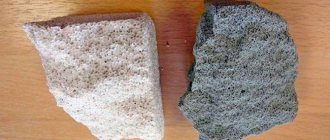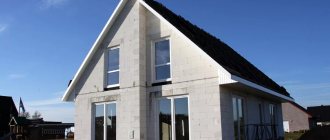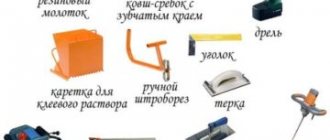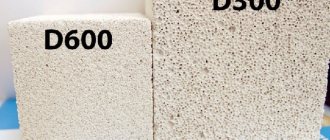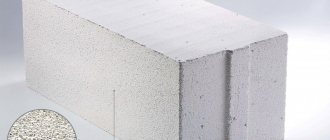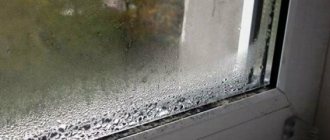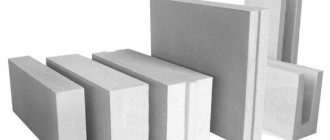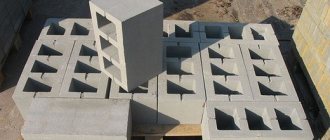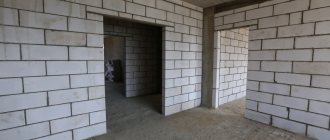Recently, when advertising has become an integral engine of trade, more and more consumers are encountering the other side of the “advertising coin” in different areas of life. In a large number of cases, in pursuit of inviting advantages, people come across existing and not displayed shortcomings.
In the construction industry, advertising also affected the entire product range. New mixtures, insulation and roofing materials, decorative products, etc. are advertised. In the field of materials for the construction of walls, gas silicate blocks are the most advertised material. Let's pay attention to the pros and cons of this material.
High adsorption
The advertisement talks about the structure of the material, permeated with air pores, which should provide us with the highest air thermal insulation performance, which exceeds that of a brick wall.
Logically, everything is correct, but the porosity and physical structure of the material has high adsorbing characteristics. Moisture that gets into the material penetrates through all internal channels, thereby reducing thermal insulation and making a house made of gas silicate blocks cold.
In addition, absorbed moisture has a destructive effect on aerated concrete itself, reducing its durability. This disadvantage in construction is offset by a rather expensive complex for waterproofing gas silicate blocks and excluding their use for wet rooms and in open facade decoration.
Advantages and disadvantages of gas silicate blocks
Any building material has characteristic advantages and disadvantages that determine the scope of its application. Let's take a closer look at the pros and cons of the GSB.
Advantages of aerated concrete
The main advantages of gas silicate blocks include:
- moderate weight
. For comparison, a concrete block of similar volume weighs 5 times more. This allows you to relieve the foundation, and also simplifies delivery and installation; - high compressive strength of products
. For a D500 block, this figure is 40 kg/cm2; Such strength allows you to build even 5-story buildings; - unique thermal insulation properties.
According to this indicator, GSB is 8 times superior to its concrete counterparts; - porous block structure.
This structure increases the soundproofing characteristics of the material. According to this criterion, GSB is 10 times superior to brick; - environmental safety
. Gas silicate blocks are made from natural materials, do not cause allergic reactions and do not emit toxic compounds into the atmosphere; - high degree of fire safety.
GSB not only do not burn, but also prevent the spread of fire. - high vapor permeability
. This parameter for aerated concrete is comparable to that of natural wood. The presence of this property allows you to create a healthy, comfortable microclimate in the room.
Cons of gas blocks
Along with the significant advantages of GSB, they also have significant disadvantages:
- Low mechanical strength
. It is not recommended to hang heavy pieces of furniture on a wall made of aerated concrete blocks, since when the fasteners are hammered in, the blocks can crumble and crack; - Low frost resistance
. With sharp temperature fluctuations, the structure of the material may be destroyed; - Increased water absorption.
The porous structure of GSB promotes intense moisture absorption, which negatively affects the strength and durability of the material when the temperature drops; - Low degree of adhesion to cement-sand plasters
. Applying such plaster compositions to the surface of aerated concrete is fraught with peeling. The use of gypsum polymer mixtures for external work is also undesirable, since such compositions do not tolerate temperature changes;
Despite the disadvantages listed above, due to their advantages and affordable cost, GSB are widely used in private construction. Let's look at a few examples.
Failure to meet GOST standards for thermal insulation
The thickness of the gas silicate masonry, declared by the manufacturers, is 38 cm. It does not satisfy the existing GOST standards for thermal insulation. Accordingly, with such masonry, the costs of air conditioning and heating increase, which is also a disadvantage.
To comply with GOST standards, gas silicate masonry with a width of 64 cm is required, which slightly contradicts the fact that manufacturers produce blocks with a maximum thickness of up to 60 cm.
Bathhouse made of gas silicate blocks: pros and cons
The construction of baths from GSB has both advantages and disadvantages. Let's look at them in more detail.
Pros of a bathhouse from the GSB
The main advantages of baths made of aerated concrete blocks are considered to be:
- Good thermal insulation. This indicator for GSB is comparable to natural timber;
- High hardness and density of the material. According to these parameters, aerated concrete is not inferior to either brickwork or a wooden frame;
- Environmental friendliness. The material is not gas silicate blocks and does not contain any substances harmful to humans;
- Biological resistance. Rodents cannot cause any harm to GSB. The spread of fungus, mold and other microorganisms is also difficult;
- High pace of construction. Walls made of aerated concrete are erected much faster than those made of timber or brick;
- Relatively small mass. The porous structure of the material makes it much easier, making it possible to carry out construction without the use of special equipment. In addition, a massive foundation is not required;
Disadvantages of GSB baths
The most significant disadvantages of baths include:
- high hygroscopicity
. GSB walls intensively absorb moisture and slowly release it. This increases the humidity in the room, and in some cases can lead to the appearance of mildew and mold; - the need for additional investments
. In order for the steam room to have a natural and attractive appearance, it is advisable to cover the walls and ceiling with clapboard made of linden or other natural wood, which will entail additional costs; - insufficiently comfortable conditions
. In a steam room made from natural wood, the microclimate is more favorable; - ventilation of the masonry.
If counterfeit or low-quality glue is used, the masonry will not be completely sealed.
Houses built from GSB have similar advantages and disadvantages, as eloquently evidenced by the reviews from residents and experts below.
Advantages of aerated concrete over gas silicate
The presence of a large number of pores in the gas slicate structure not only gives the block advantages, but also worsens some of its parameters. Due to its denser structure, aerated concrete has a high degree of moisture resistance and frost resistance. Therefore, excessive moisture and temperature changes do not destroy it from the inside.
High fire resistance allows a block of aerated concrete with a layer of plaster to withstand open fire without ignition for two hours. Autoclaved concrete has a worse ability. It is impossible to say unequivocally that savings when using aerated concrete are greater. Despite its low cost, it is smaller in size than gas silicate. The possibility of saving on adhesive material is eliminated if additional finishing is required to increase thermal insulation.
Types of aerated concrete
Each type of aerated concrete is intended for a specific type of work; aerated concrete products are marked for this purpose. For the construction of large buildings, residential buildings and other structures of this type, the D1000 or D1200 grade of aerated concrete is used. The second type of aerated concrete - D200-D500 is used mainly for insulation. The next type of aerated concrete is D500-D900.
It can be used for the construction of small structures, as well as for insulation. Usually they try to use the D700 grade for the construction of walls. You should know that you cannot build a skyscraper from aerated concrete; I use this type of material in the construction of houses whose height is no more than 9 floors. Depending on the loads, the appropriate brand of aerated concrete is used.
Each brand has its own density - kg/m. Blocks with a density from 200 to 350 are used exclusively for insulating buildings. If the house has no more than 2 floors, then aerated concrete with a density of 400-600 can be used. Construction of up to 3 floors should be made of blocks with a density of 500-700. Over 700 blocks are used for the construction of buildings above 3 floors, but it is necessary to reinforce the rows between the blocks.
Roofing for a house made of aerated concrete
Before installing the floor slabs, a monolithic belt is installed. Next, lay a rafter system made of 100x100 mm timber. The roofing material is chosen from any type of coating existing on the construction market. It should be taken into account that the roof structure should not weigh down the load-bearing walls more than the load allowed by the design. The roof can be flat or pitched, and the number of slopes is not limited. As a covering, choose soft tiles, metal tiles, corrugated sheets
If it is important that the roof has sound-absorbing ability, choose bitumen (soft) shingles
Comparison of silicate block and gas block
For easy comparison of indicators, you can use the table. Certain parameters are indicated in a range because they depend on the dimensions and density of the block material.
| Indicators | Aerated concrete material | Silicate blocks |
| Components | Gypsum, quicklime, cement paste, sand, aluminum powder, clean water | Sifted sand, water, lime |
| Application area | Construction of low-rise private buildings, high-rise buildings with a monolithic frame | Construction of low-rise private buildings, high-rise buildings with a monolithic frame |
| Permissible height value | No more than three floors | Up to nine floors |
| Parameters of length, width, height, cm | 62.5 x 10 x 25 62.5 x 20 x 25 62.5 x 30 x 25 62.5 x 40 x 25 | 49.8 x 8 x 24.8 49.8 x 18 x 24.8 24.8 x 24.8 x 24.8 |
| Strength grade | M150 | |
| Concrete strength class | B 2.5 – 3.5 | |
| Dry thermal conductivity index, W | 0.14 | 0.418 |
| Resistance to temperature changes | 75 to 100 cycles | Up to 50 cycles |
| Soundproofing | 39 – 43 dB | 55 – 58 dB |
| Density indicator, kg per cubic meter | From 500 to 600 | From 1,100 to 1,600 |
| Deviations in geometric parameters | No more than 1 mm per meter | No more than 1 mm per meter |
Disadvantages of the material
- Hygroscopicity, as is the case with other options for cellular concrete, is very high for gas silicate blocks. Having absorbed a lot of water, such a block becomes susceptible to destruction, loses its performance characteristics, and also provides the fungus with an excellent environment for reproduction. As a result, additional waterproofing measures are required;
- Low strength. When attaching heavy structures to walls, it is necessary to use special dowels;
- Mediocre frost resistance, which also increases the cost of protective measures;
- Shrinkage of these materials can be quite significant. For this reason, every three to four rows it is better to use reinforcing mesh or reinforcement. Otherwise, the walls may crack over time;
- As is the case with all porous concrete, thermal insulation properties decrease as strength characteristics increase.
What are gas silicate blocks and how are they produced?
Sweden can be considered the birthplace of gas silicate blocks. The manufacturing technology of this autoclaved cellular concrete has remained virtually unchanged since the beginning of the last century.
The blocks are based on high-quality cement, gypsum, lime and water. All these materials are mixed together, after which aluminum powder is added to the solution. The latter reacts with lime, causing the release of gas and the composition is filled with small pores. Modern technologies make it possible to regulate the size of pores.
After mixing the material, pouring it into molds and cutting the latter, the blocks are sent to autoclaves, where they undergo the final strengthening and impart those performance characteristics for which gas silicate is valued. However, there is also a non-autoclave production method, but in this case gas silicate blocks are less durable and less environmentally friendly.
Foundation for a house made of aerated concrete
The lightness of the structure allows you to get by with a shallow strip or slab foundation. However, it must be correctly calculated to ensure the following conditions for the structure:
- prevent wall deformation,
- accept and distribute the load correctly,
- be resistant to groundwater movement and low temperatures.
The cost of a strip foundation is lower than a slab foundation. In this case, the slab is installed on moving, complex, loose soils. Before erecting a foundation, consider drainage and vertical waterproofing of its walls. Hardening of concrete occurs within a month. After this, the base is covered with a waterproofing film or bitumen-polymer roll material.
What blocks can be called gas silicate
First of all, it makes sense to determine which building blocks belong to gas silicate, since in discussions almost all types of lightweight concrete products are included in this category, with the exception of expanded clay and slag concrete blocks. In accordance with the international patent received in 1924 for this material, the following blocks can be called gas silicate:
- which, in addition to the filler (quartz sand with a limited content of impurities, water with regulated hardness), as a binder component includes a lime-cement mortar with a weight content of ground quicklime of about 75% , and as a blowing agent - aluminum pastes or powders containing at least 90% metal fraction from 20 to 45 microns ;
- in which pore formation occurs due to the appearance of hydrogen during stirring of the liquid mixture, saturating the finished mass with bubbles; as a result, the hardened material has many small, evenly distributed pores of the same size and regular shape;
- hardening of which is carried out in autoclaves at a pressure of 8 to 12 atmospheres and at a temperature of about 200ºС, which makes it possible to completely bind active aluminum, eliminating the possibility of its impact on the environment, and also to achieve stability of the thermal characteristics of the material due to the hydrophobization of cement stone.
In order to determine the validity of the costs of gas silicate blocks, the disadvantages and advantages of these products should be compared with materials of the same purpose and with similar properties.
Construction from various blocks
Our company uses various types of blocks for the construction of country houses. These include large-format ceramic blocks Rauff - a relatively new material for construction, which is becoming increasingly popular. A special production technology allows this material to perfectly retain heat due to its cellular structure. It is reliable and has excellent fire resistance. Since the block is large-format, this makes it possible to reduce construction time.
Construction from a time-tested material – AEROC aerated concrete blocks – is also common. High load-bearing capacity with minimal specific gravity is combined with low thermal conductivity, which will allow you to save on fuel when heating your home, be it stoves or steam heating. At its core, aerated concrete is a porous artificial stone. Construction from stone has always been considered the most reliable. And although the prices for stone construction cannot be called very low, the costs will be repaid a hundredfold by reliability and durability.
Roofing a house made of aerated concrete
Depending on the angle of the roof slope, the roof area will be from 120 to 150 m2.
Rafter system – 100 t.r.
Roofing material – 70-200 t.r.
Roof insulation with mineral wool - 20 - 50 tr.
The rafter system includes: mauerlat, rafter beams, rafters, counter-lattice, sheathing.
Roofing materials include: waterproofing, vapor-permeable membrane, and the roof itself, including flashings, ridge and other drainage elements. Roofing materials can be slate, ondulin, metal tiles, flexible tiles, ceramic tiles.
Since the main heat loss occurs on the roof, its insulation with mineral wool is simply necessary. The required insulation thickness is 10-20 cm.
Square of Rockwool stone wool, 100 mm thick. will cost 120 rubles.
150 squares of cotton wool will cost from 20 to 40 tr. depending on thickness.
